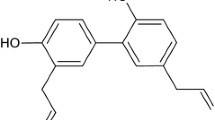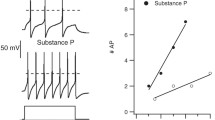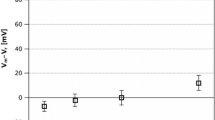Summary
Intracellular recordings were made to investigate the responses of membrane potential to acetylcholine (ACh) on neurons in isolated toad dorsal root ganglion (DRG). In the 73 neurons examined, 67 were of type A, and the remaining 6 of type C cell. The resting membrane potential of these two types of cells was −67.5±1.3 mV (× ±SE). During the application of ACh (4 × 10-4–6 × 10-4 mol/L), the changes in membrane potential were as follows: 1) hyperpolarization, with amplitude of 9.1±3.0 mV (X ± SE; n = 23); 2) depolarization, with amplitude of 12.9 ±2.2 mV (X ±SE; n = 20); 3) biphasic response, i.e., hyperpolarization with amplitude of 8.0±2.4 mV (X±SE) followed by depolarization with amplitude of 10.9±2.1 mV (X±SE) (n=24); no effect (n=6).
The hyperpolarization induced by ACh was blocked by superfusion with atropine (1.3 × 10-5 mol/L; n = 23), while ACh depolarization was blocked by the mixture of d-tubocurarine (1.4 × 10-5 mol/L) and hexamethonium (1.4 ×10-5 mol/L) (n = 18). When ACh caused hyperpolarization, the membrane conductance wascin reased by 13.8% and the reversal potential was about -96 mV (n=3). TEA (20 mmol/L) superfusion enhanced ACh depolarization amplitude by 48.2 ±3.2 % (× ± SE;n = 6), and depressed ACh hyperpolarization amplitude by 79.4 ±4.3 % (× ± SE; n= 8).MnCl2 (4 mmol/l) superfusion decreased the amplitudes of ACh depolarization and hyperpolarization by 54.2 ±7.2 % (X ±SE; n= 5) and by 69.2±6.4 % (X±SE; n = 14) respectively. These results suggest that the depolarization and hyperpolarization induced by ACh are mediated by nicotinic and muscarinic receptors on the soma of toad DRG neurons separately, and it seems that ACh hyperpolarization involves activation of calcium-activated potassium conductance.
Similar content being viewed by others
References
1988;40(3): 240–9.
1989;41(2): 145–52.
Morita K, Katayama Y. Two types of acetylcholine receptors on the soma of primary afferent neurons. Erain Res 1984; 290:348–52.
1987;:26–27.
Ito M. The electrical activity of spinal ganglion cells investigated with intracellular microelectrodes. Jap J Physiol 1957;7:297–323.
Akasu T, et al. Noradrenaline hyperpolarization and depolarization in cat vesical parasympathetic neurons. J Physiol 1985; 361:165–84.
Smith PA, Weight FF. The pathway for the slow inhibitory postsynaptic potential in bullfrog sympathetic ganglia. J Neurophysiol 1986; 56:823–24.
McCormick DA, Prince DA. Actions of ACh in the guinea-pig and cat medial and lateral geniculale nuclei in vitro. J Physiol 1987, 392:147–65.
Li ZW, Li CY. Muscarinic receptor mediated hyperpolarization of somata membrane in toad dorsal root ganglion neurons and Us underlying ionic basis. Trends Pharmacol Sci 1900. (in press).
1988; 37–8.
Cole AE, Shinniok-Gallagher P. Muscarinic inhibitory transmission in mammalian sympathetic ganglia mediated by increased potassium conductance. Nature 1984; 207:370–1.
Dun NJ, Jiang ZG. Non-cholinergic excitatory transmission in inferior mesenteric ganglia of the guinea-pig: possible mediation by substance P. J Physiol 1982; 325:145–59.
Nishi S, et al. Primary afferent neurons the ionic mechanism of GABA-mediated depolarization. Neuropharmacology 1974;13:215–9.
Holz IV, et al. Serotonin depolarizes type A and C primary afferents; an intracellular study in bullfrog dorsal root ganglion. Brain Res 1985; 327: 71–9.
Hunt SP, Ninkovic M. Ceratin substance P-like immunoreactive dorsal root ganglion cells possess opiate and/or histamine binding sites. Er J Pharmacol 1983; 79:414p.
Ninkovic M, Hunt SP. Opiate and histamine H1 receptors are present on some substance P-containing dorsal root ganglion cells. Neurosci Lett 1985; 53: 133–7.
Ninkovic M, et al. Localization of opiate and histamine H1-receptors in the primary sensory ganglia and spinal cord. Erain Res 1982; 241:197–206.
Author information
Authors and Affiliations
Rights and permissions
About this article
Cite this article
Chao-ying, L., Zhi-wang, L. Effect of acetylcholine on membrane potential in toad dorsal root ganglion neurons and its underlying ionic basis. Journal of Tongji Medical University 9, 210–215 (1989). https://doi.org/10.1007/BF02909085
Issue Date:
DOI: https://doi.org/10.1007/BF02909085




